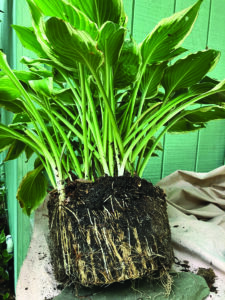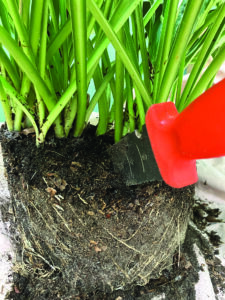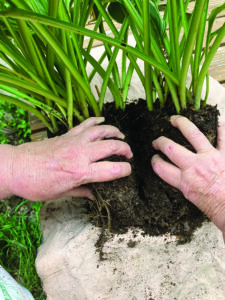
Overcrowded plants have to compete for nutrients and water and can become diseased if they don’t get enough air flow. Potted perennials should be divided before they are totally root bound, like this hosta.
Perennials are plants that die back to the ground with the first freeze but reappear in spring.
Perennials may cost more than annuals initially, but you don’t have to buy them again and can enjoy them year after year.
An added advantage is that many of them spread to fill a space and some can be divided every few years, providing free plants for elsewhere in your garden or that of a friend.
In addition to increasing their number, division helps rejuvenate old plants and helps control their size.
When a perennial clump becomes overcrowded, it develops a hole in the center, has sparse foliage at the bottom and produces only a few flowers, it may be time to divide.
Overcrowded plants have to compete for nutrients and water and can become diseased if they don’t get enough air flow.
Potted perennials should be divided before they are totally root bound.
It’s usually best to divide spring or summer blooming perennials in fall, when the foliage dies down but several weeks before the first frost.
Fall-blooming perennials are preferably divided in early spring, as soon as the growing tips emerge.
Dividing in spring gives the plants a whole season to recover and establish a good root system.
You can plant these divisions in the garden before the ground freezes or pot them up until spring.
Before you start, water thoroughly for a day or two.
Watering helps the plant and makes it easier to dig.
Don’t divide perennials on a hot, sunny day; that will stress the plant.
Wait for a cooler, cloudy day, ideally when several days of rain are forecast.
If you’re going to put the divisions in the ground, it’s best to prepare the new area before you disturb the original plant.
The less time out of the ground, the better.
If you are delayed, keep the roots moist. Dig a hole deep enough to accommodate the roots when the crown of the plant is even with the soil surface and make it plenty wide enough.
You may want to add compost to improve water-holding capacity and provide nutrients. It’s better to hold off on fertilizer for awhile.
Dig around the plant in a circle beyond the drip line of the plant’s leaves, deep enough to keep the root system intact. Lift the root ball out of the hole.
Removing loose soil by shaking gently or squirting with a hose will make it easier to see what you are doing.
Perennials have several different types of root systems, each of which requires a little different treatment when dividing.
The types include spreading root systems, clumping root systems, rhizomes and tuberous bulbs.

Look for a fairly clear path through the mass of stems. You may have to sacrifice one in the middle, but in this case, division leads to addition.
Spreading root systems have many slender, matted roots that seem to have no distinct pattern. Examples are aster, bee balm, lamb’s ear and purple coneflowers (echinacea).
Often you can tease the roots apart by hand or cut them apart with shears or a knife. A favorite tool of many gardeners is a “hori hori” knife with one sharp edge and one serrated edge. “Hori” is Japanese for “dig.”
A serrated bread knife could substitute, but the hori hori knife has a sharp point for digging and a stronger blade.
For larger, more vigorous plants whose roots are thickly intertwined, try separating them with two digging forks.
If all else fails, put the clump back in its hole and use a spade to cut it in half, or resort to a tree saw.
Depending on the size of the original plant, divide the clump into three to five healthy shoots. Discard the center if it looks weak, along with any weak or wood pieces.
Clumping root systems originate from a central clump and grow in multiple directions.
Examples are astibles, daylilies, hostas and many ornamental grasses.
Cut through the crown with one of the above tools. Each division should have at least one developing eye or bud and some roots.
Be aware that smaller divisions may not flower for a year or two until established.
Rhizomes are stems that grow horizontally at or above the soil level.
Bearded irises are the most common perennial with this type of roof system. After lifting a clump, remove and discard any rhizome sections that have been damaged by insects or disease and those that are soft or soggy.
Each division should include a few inches of rhizome and one fan of leaves. Cut the leaves back by one-half.
When replanting, leave the top of the rhizome barely showing above soil level.
Tuberous roots should be cut apart with a sharp knife, making sure each section has a piece of the original stem and a growth bud attached. Dahlias and daylilies have tuberous roots.
Some plants just should not be divided, including (but not limited to) baby’s breath, balloon flower, bugbane, butterfly weed, clematis, columbine, euphorbia, false indigo and Japanese anemones.
Others, like Lenten rose (Helleborus) are difficult to move as mature plants and it’s much easier to learn to identify tiny seedlings which can be transplanted.
Bleeding heart and peonies usually don’t need to be divided except to increase your number of plants.

Look for a fairly clear path through the mass of stems. You may have to sacrifice one in the middle, but in this case, division leads to addition. (Photos by Carol Kinsley)




